Income Tax Law: Residence and Taxable Income Analysis Report
VerifiedAdded on 2021/06/14
|11
|1641
|34
Report
AI Summary
This report delves into Australian income tax law, presenting a detailed analysis of taxable income computation and residency determination based on the provided case studies. Part 1 of the report provides a statement of advice, calculating assessable income and deductions, including detailed working notes and considerations for a client named Dale. It addresses various aspects of business expenses, including allowable deductions for business-related expenditure, superannuation contributions, tax agent fees, and business insurance premiums, while also explaining non-deductible expenses such as life insurance premiums. Part 2 focuses on assessing the residency status of an individual named Emity, considering domicile, the 183-day test, the ordinary concept test, and the superannuation test, referencing relevant legislation and case law to determine whether she qualifies as an Australian resident for tax purposes. The report concludes that Emity will be held as the Australian resident as per the “Domicile Act 1982”. The report cites various sources to support its analysis.
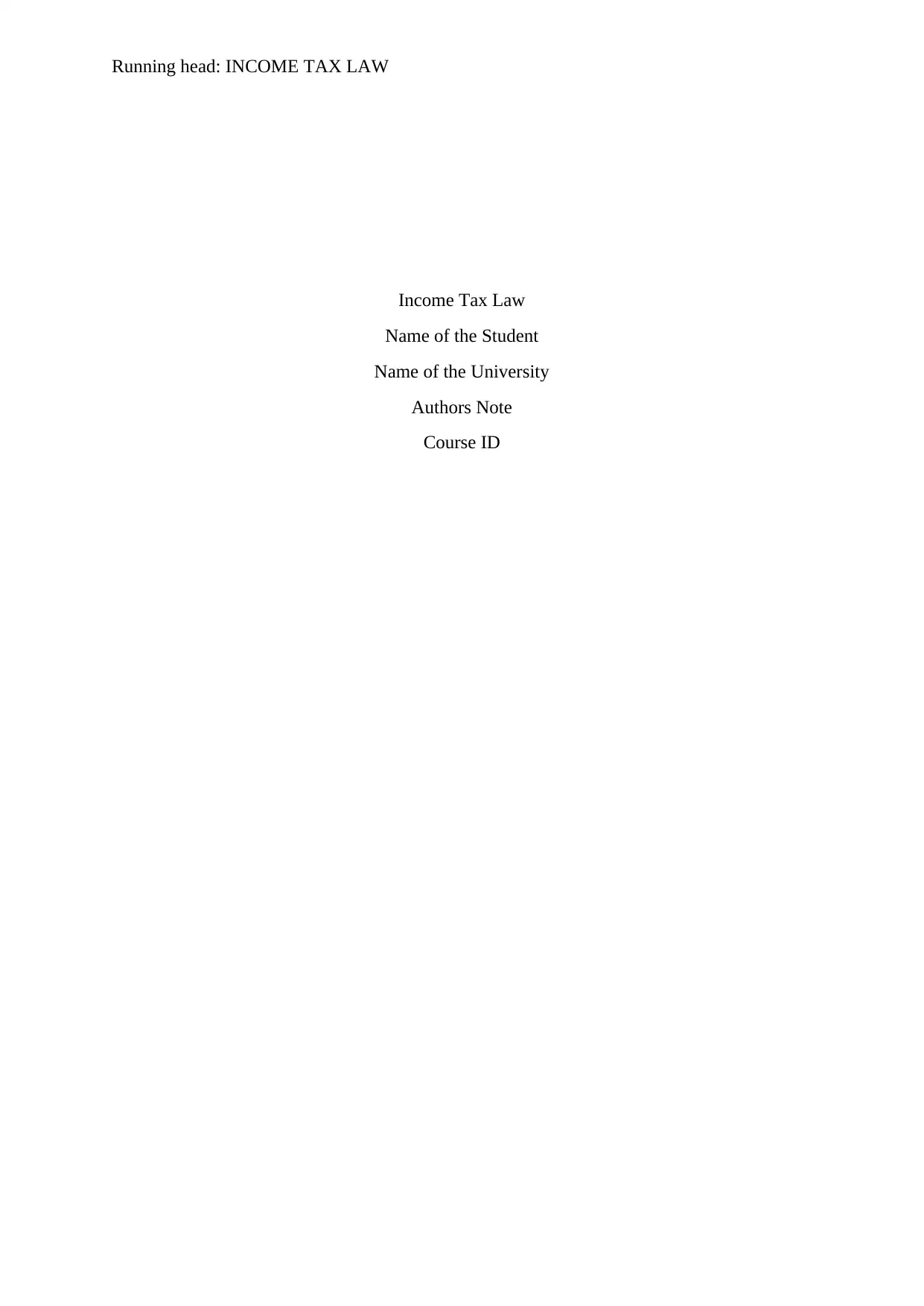
Running head: INCOME TAX LAW
Income Tax Law
Name of the Student
Name of the University
Authors Note
Course ID
Income Tax Law
Name of the Student
Name of the University
Authors Note
Course ID
Paraphrase This Document
Need a fresh take? Get an instant paraphrase of this document with our AI Paraphraser
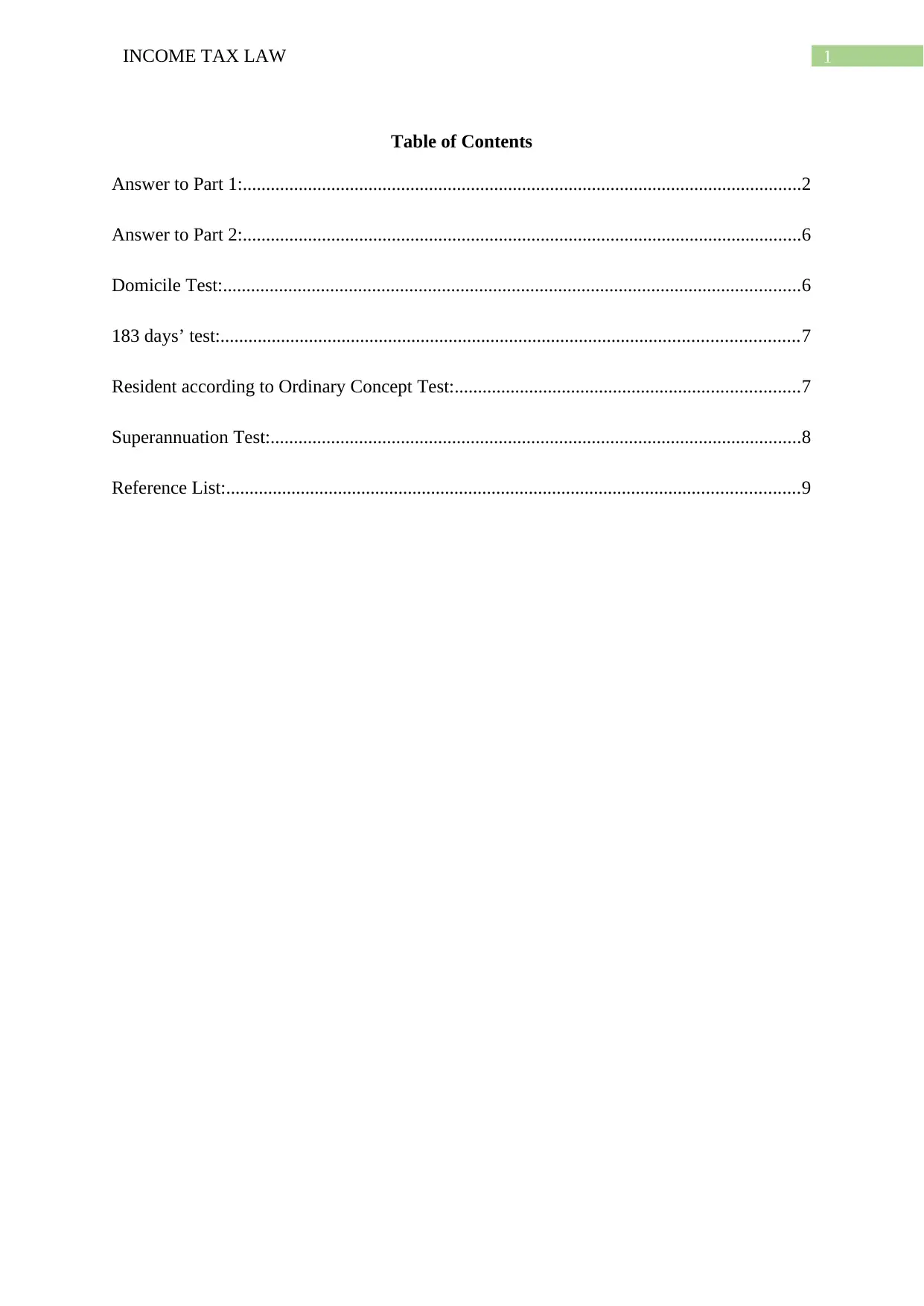
1INCOME TAX LAW
Table of Contents
Answer to Part 1:........................................................................................................................2
Answer to Part 2:........................................................................................................................6
Domicile Test:............................................................................................................................6
183 days’ test:............................................................................................................................7
Resident according to Ordinary Concept Test:..........................................................................7
Superannuation Test:..................................................................................................................8
Reference List:...........................................................................................................................9
Table of Contents
Answer to Part 1:........................................................................................................................2
Answer to Part 2:........................................................................................................................6
Domicile Test:............................................................................................................................6
183 days’ test:............................................................................................................................7
Resident according to Ordinary Concept Test:..........................................................................7
Superannuation Test:..................................................................................................................8
Reference List:...........................................................................................................................9
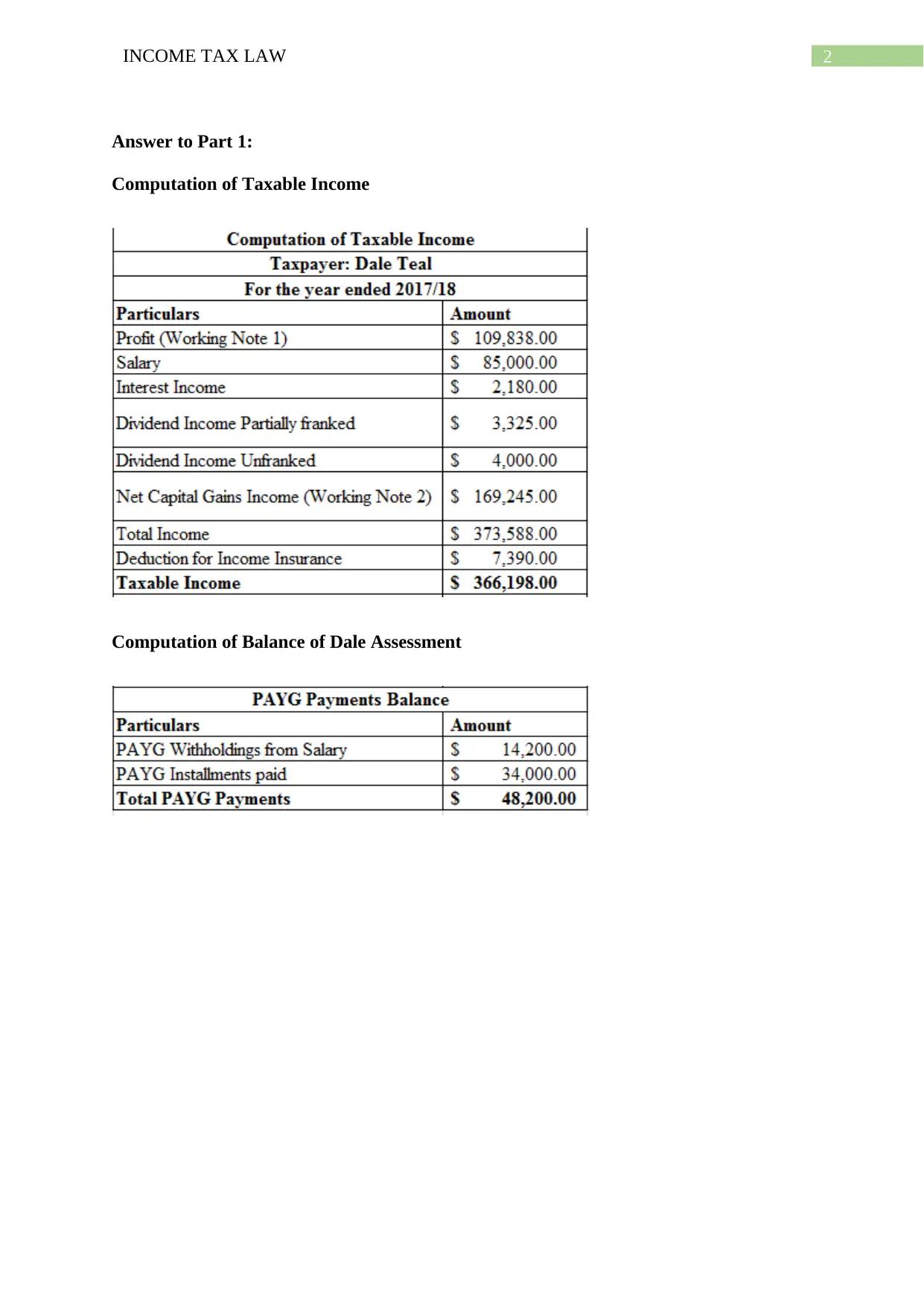
2INCOME TAX LAW
Answer to Part 1:
Computation of Taxable Income
Computation of Balance of Dale Assessment
Answer to Part 1:
Computation of Taxable Income
Computation of Balance of Dale Assessment
⊘ This is a preview!⊘
Do you want full access?
Subscribe today to unlock all pages.

Trusted by 1+ million students worldwide
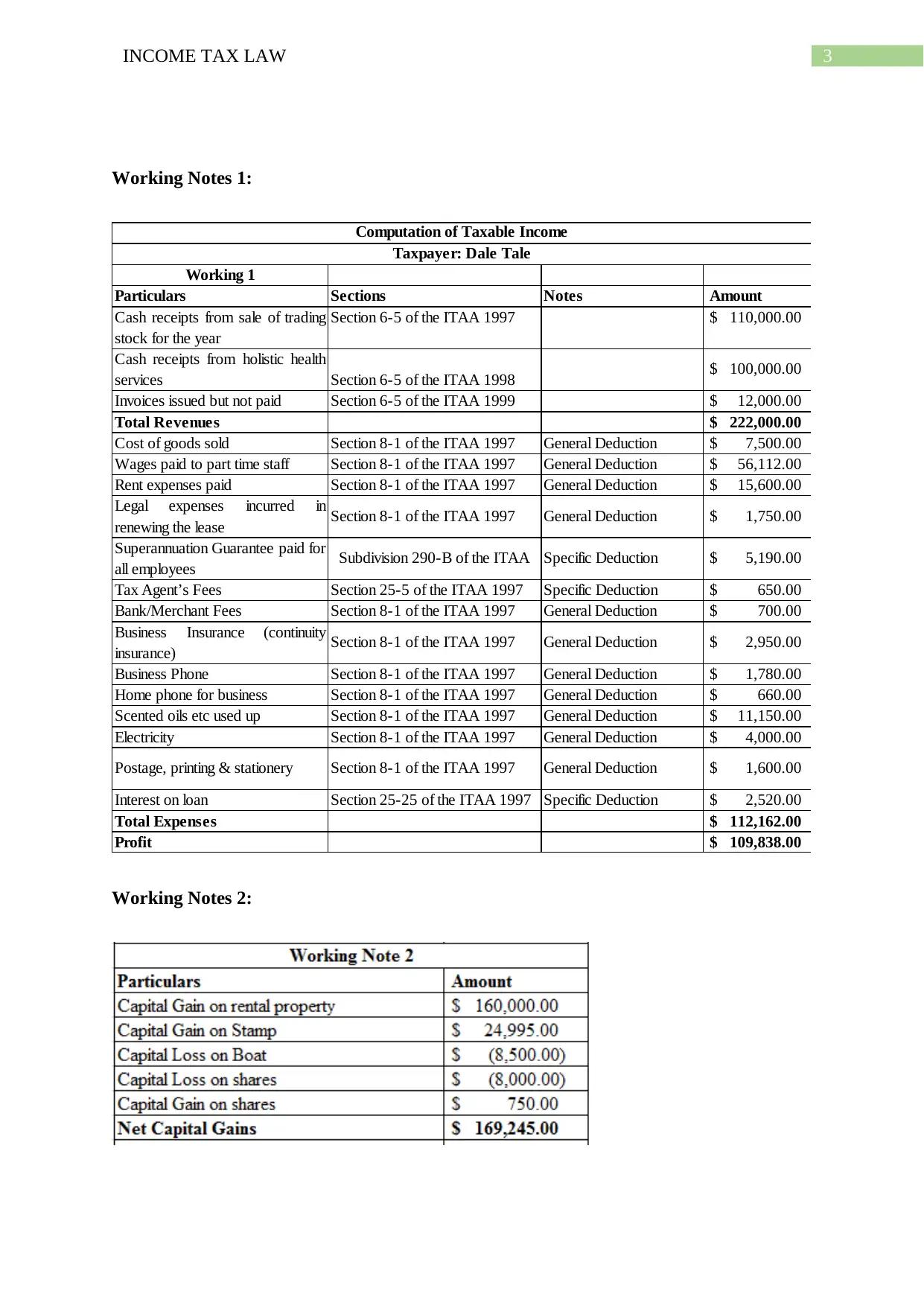
3INCOME TAX LAW
Working Notes 1:
Working 1
Particulars Sections Notes Amount
Cash receipts from sale of trading
stock for the year
Section 6-5 of the ITAA 1997 $ 110,000.00
Cash receipts from holistic health
services Section 6-5 of the ITAA 1998 $ 100,000.00
Invoices issued but not paid Section 6-5 of the ITAA 1999 $ 12,000.00
Total Revenues $ 222,000.00
Cost of goods sold Section 8-1 of the ITAA 1997 General Deduction $ 7,500.00
Wages paid to part time staff Section 8-1 of the ITAA 1997 General Deduction $ 56,112.00
Rent expenses paid Section 8-1 of the ITAA 1997 General Deduction $ 15,600.00
Legal expenses incurred in
renewing the lease Section 8-1 of the ITAA 1997 General Deduction $ 1,750.00
Tax Agent’s Fees Section 25-5 of the ITAA 1997 Specific Deduction $ 650.00
Bank/Merchant Fees Section 8-1 of the ITAA 1997 General Deduction $ 700.00
Business Insurance (continuity
insurance) Section 8-1 of the ITAA 1997 General Deduction $ 2,950.00
Business Phone Section 8-1 of the ITAA 1997 General Deduction $ 1,780.00
Home phone for business Section 8-1 of the ITAA 1997 General Deduction $ 660.00
Scented oils etc used up Section 8-1 of the ITAA 1997 General Deduction $ 11,150.00
Electricity Section 8-1 of the ITAA 1997 General Deduction $ 4,000.00
Postage, printing & stationery Section 8-1 of the ITAA 1997 General Deduction $ 1,600.00
Interest on loan Section 25-25 of the ITAA 1997 Specific Deduction $ 2,520.00
Total Expenses $ 112,162.00
Profit $ 109,838.00
Superannuation Guarantee paid for
all employees Specific Deduction $ 5,190.00
Taxpayer: Dale Tale
Computation of Taxable Income
Subdivision 290-B of the ITAA
Working Notes 2:
Working Notes 1:
Working 1
Particulars Sections Notes Amount
Cash receipts from sale of trading
stock for the year
Section 6-5 of the ITAA 1997 $ 110,000.00
Cash receipts from holistic health
services Section 6-5 of the ITAA 1998 $ 100,000.00
Invoices issued but not paid Section 6-5 of the ITAA 1999 $ 12,000.00
Total Revenues $ 222,000.00
Cost of goods sold Section 8-1 of the ITAA 1997 General Deduction $ 7,500.00
Wages paid to part time staff Section 8-1 of the ITAA 1997 General Deduction $ 56,112.00
Rent expenses paid Section 8-1 of the ITAA 1997 General Deduction $ 15,600.00
Legal expenses incurred in
renewing the lease Section 8-1 of the ITAA 1997 General Deduction $ 1,750.00
Tax Agent’s Fees Section 25-5 of the ITAA 1997 Specific Deduction $ 650.00
Bank/Merchant Fees Section 8-1 of the ITAA 1997 General Deduction $ 700.00
Business Insurance (continuity
insurance) Section 8-1 of the ITAA 1997 General Deduction $ 2,950.00
Business Phone Section 8-1 of the ITAA 1997 General Deduction $ 1,780.00
Home phone for business Section 8-1 of the ITAA 1997 General Deduction $ 660.00
Scented oils etc used up Section 8-1 of the ITAA 1997 General Deduction $ 11,150.00
Electricity Section 8-1 of the ITAA 1997 General Deduction $ 4,000.00
Postage, printing & stationery Section 8-1 of the ITAA 1997 General Deduction $ 1,600.00
Interest on loan Section 25-25 of the ITAA 1997 Specific Deduction $ 2,520.00
Total Expenses $ 112,162.00
Profit $ 109,838.00
Superannuation Guarantee paid for
all employees Specific Deduction $ 5,190.00
Taxpayer: Dale Tale
Computation of Taxable Income
Subdivision 290-B of the ITAA
Working Notes 2:
Paraphrase This Document
Need a fresh take? Get an instant paraphrase of this document with our AI Paraphraser
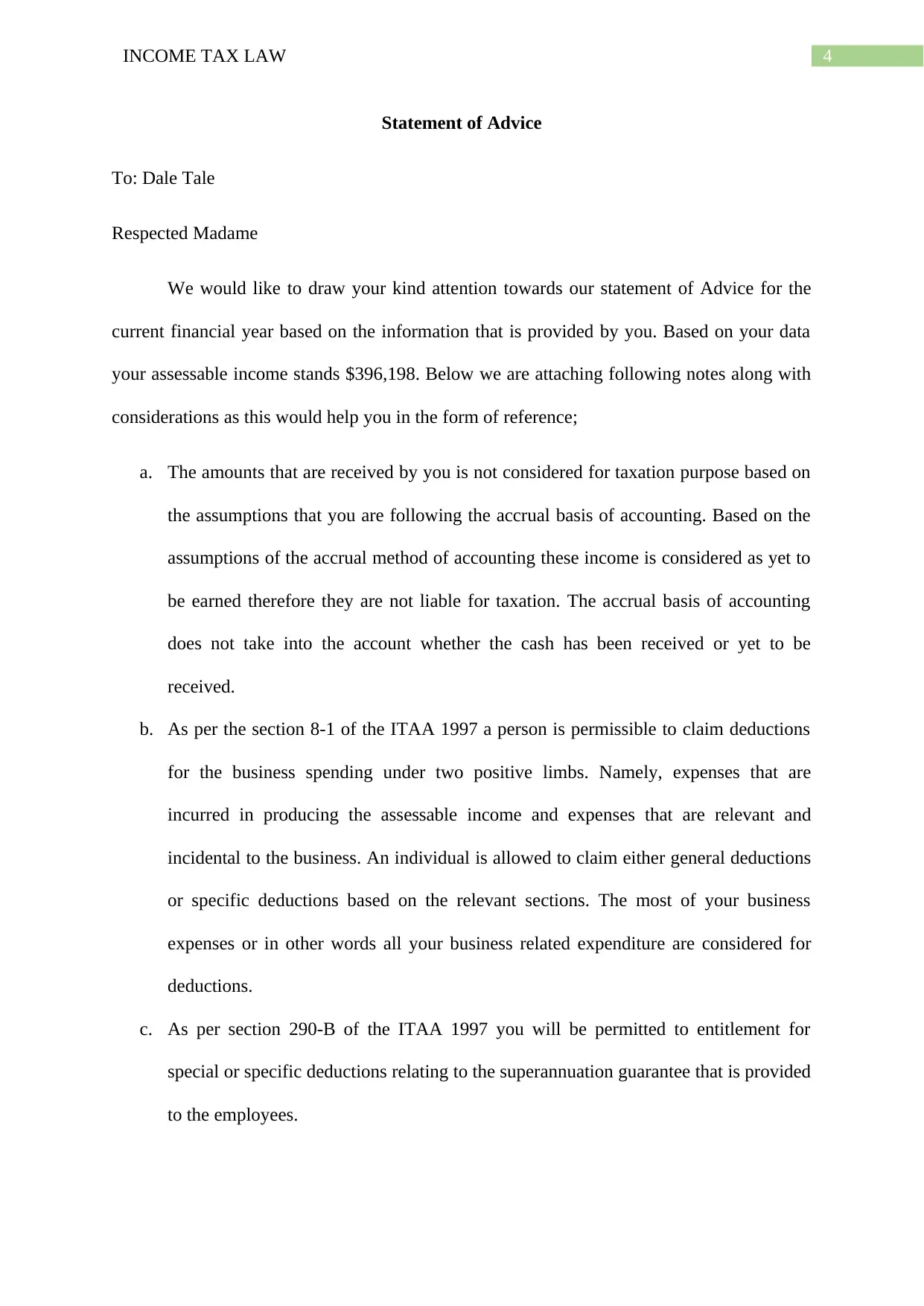
4INCOME TAX LAW
Statement of Advice
To: Dale Tale
Respected Madame
We would like to draw your kind attention towards our statement of Advice for the
current financial year based on the information that is provided by you. Based on your data
your assessable income stands $396,198. Below we are attaching following notes along with
considerations as this would help you in the form of reference;
a. The amounts that are received by you is not considered for taxation purpose based on
the assumptions that you are following the accrual basis of accounting. Based on the
assumptions of the accrual method of accounting these income is considered as yet to
be earned therefore they are not liable for taxation. The accrual basis of accounting
does not take into the account whether the cash has been received or yet to be
received.
b. As per the section 8-1 of the ITAA 1997 a person is permissible to claim deductions
for the business spending under two positive limbs. Namely, expenses that are
incurred in producing the assessable income and expenses that are relevant and
incidental to the business. An individual is allowed to claim either general deductions
or specific deductions based on the relevant sections. The most of your business
expenses or in other words all your business related expenditure are considered for
deductions.
c. As per section 290-B of the ITAA 1997 you will be permitted to entitlement for
special or specific deductions relating to the superannuation guarantee that is provided
to the employees.
Statement of Advice
To: Dale Tale
Respected Madame
We would like to draw your kind attention towards our statement of Advice for the
current financial year based on the information that is provided by you. Based on your data
your assessable income stands $396,198. Below we are attaching following notes along with
considerations as this would help you in the form of reference;
a. The amounts that are received by you is not considered for taxation purpose based on
the assumptions that you are following the accrual basis of accounting. Based on the
assumptions of the accrual method of accounting these income is considered as yet to
be earned therefore they are not liable for taxation. The accrual basis of accounting
does not take into the account whether the cash has been received or yet to be
received.
b. As per the section 8-1 of the ITAA 1997 a person is permissible to claim deductions
for the business spending under two positive limbs. Namely, expenses that are
incurred in producing the assessable income and expenses that are relevant and
incidental to the business. An individual is allowed to claim either general deductions
or specific deductions based on the relevant sections. The most of your business
expenses or in other words all your business related expenditure are considered for
deductions.
c. As per section 290-B of the ITAA 1997 you will be permitted to entitlement for
special or specific deductions relating to the superannuation guarantee that is provided
to the employees.
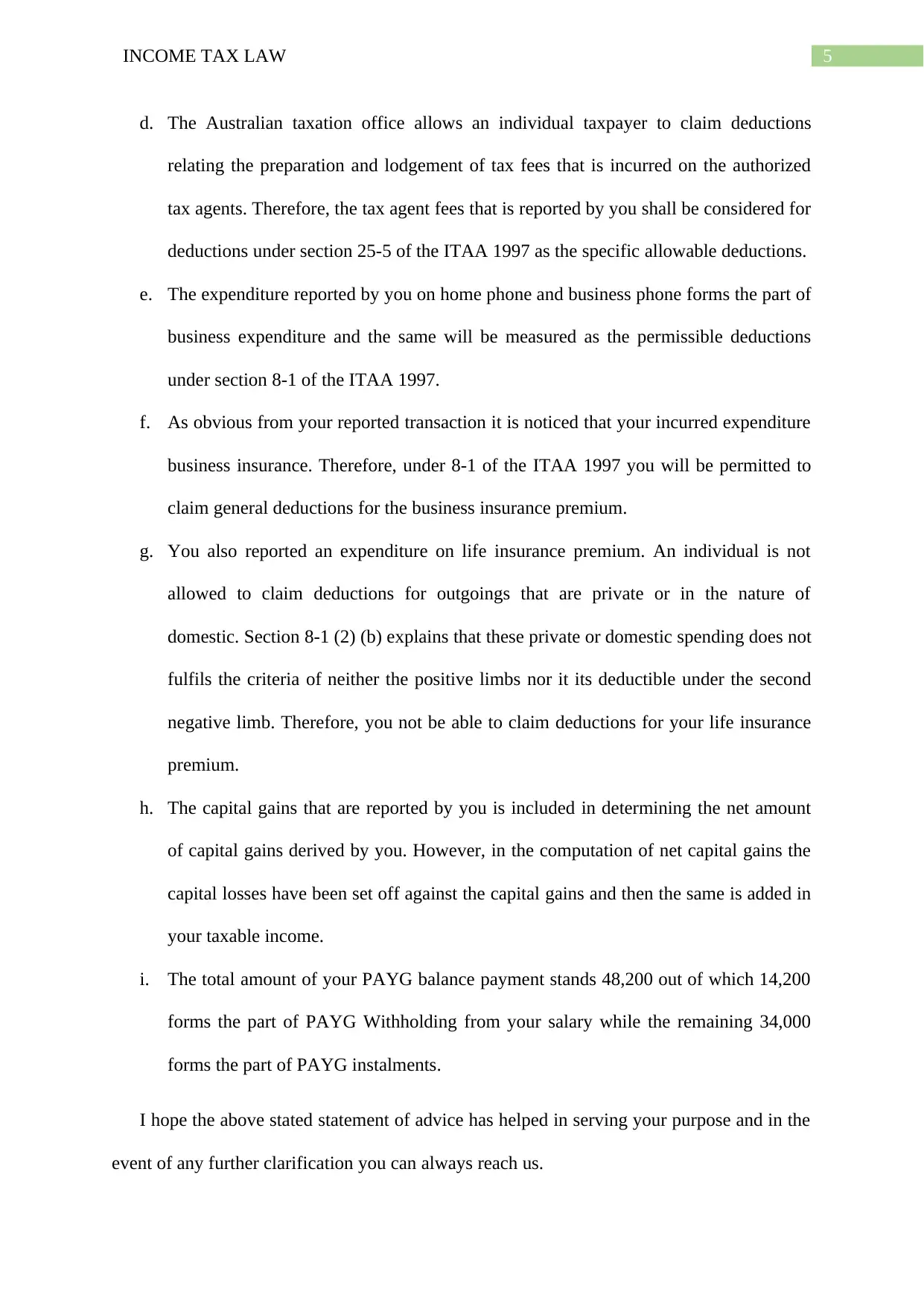
5INCOME TAX LAW
d. The Australian taxation office allows an individual taxpayer to claim deductions
relating the preparation and lodgement of tax fees that is incurred on the authorized
tax agents. Therefore, the tax agent fees that is reported by you shall be considered for
deductions under section 25-5 of the ITAA 1997 as the specific allowable deductions.
e. The expenditure reported by you on home phone and business phone forms the part of
business expenditure and the same will be measured as the permissible deductions
under section 8-1 of the ITAA 1997.
f. As obvious from your reported transaction it is noticed that your incurred expenditure
business insurance. Therefore, under 8-1 of the ITAA 1997 you will be permitted to
claim general deductions for the business insurance premium.
g. You also reported an expenditure on life insurance premium. An individual is not
allowed to claim deductions for outgoings that are private or in the nature of
domestic. Section 8-1 (2) (b) explains that these private or domestic spending does not
fulfils the criteria of neither the positive limbs nor it its deductible under the second
negative limb. Therefore, you not be able to claim deductions for your life insurance
premium.
h. The capital gains that are reported by you is included in determining the net amount
of capital gains derived by you. However, in the computation of net capital gains the
capital losses have been set off against the capital gains and then the same is added in
your taxable income.
i. The total amount of your PAYG balance payment stands 48,200 out of which 14,200
forms the part of PAYG Withholding from your salary while the remaining 34,000
forms the part of PAYG instalments.
I hope the above stated statement of advice has helped in serving your purpose and in the
event of any further clarification you can always reach us.
d. The Australian taxation office allows an individual taxpayer to claim deductions
relating the preparation and lodgement of tax fees that is incurred on the authorized
tax agents. Therefore, the tax agent fees that is reported by you shall be considered for
deductions under section 25-5 of the ITAA 1997 as the specific allowable deductions.
e. The expenditure reported by you on home phone and business phone forms the part of
business expenditure and the same will be measured as the permissible deductions
under section 8-1 of the ITAA 1997.
f. As obvious from your reported transaction it is noticed that your incurred expenditure
business insurance. Therefore, under 8-1 of the ITAA 1997 you will be permitted to
claim general deductions for the business insurance premium.
g. You also reported an expenditure on life insurance premium. An individual is not
allowed to claim deductions for outgoings that are private or in the nature of
domestic. Section 8-1 (2) (b) explains that these private or domestic spending does not
fulfils the criteria of neither the positive limbs nor it its deductible under the second
negative limb. Therefore, you not be able to claim deductions for your life insurance
premium.
h. The capital gains that are reported by you is included in determining the net amount
of capital gains derived by you. However, in the computation of net capital gains the
capital losses have been set off against the capital gains and then the same is added in
your taxable income.
i. The total amount of your PAYG balance payment stands 48,200 out of which 14,200
forms the part of PAYG Withholding from your salary while the remaining 34,000
forms the part of PAYG instalments.
I hope the above stated statement of advice has helped in serving your purpose and in the
event of any further clarification you can always reach us.
⊘ This is a preview!⊘
Do you want full access?
Subscribe today to unlock all pages.

Trusted by 1+ million students worldwide
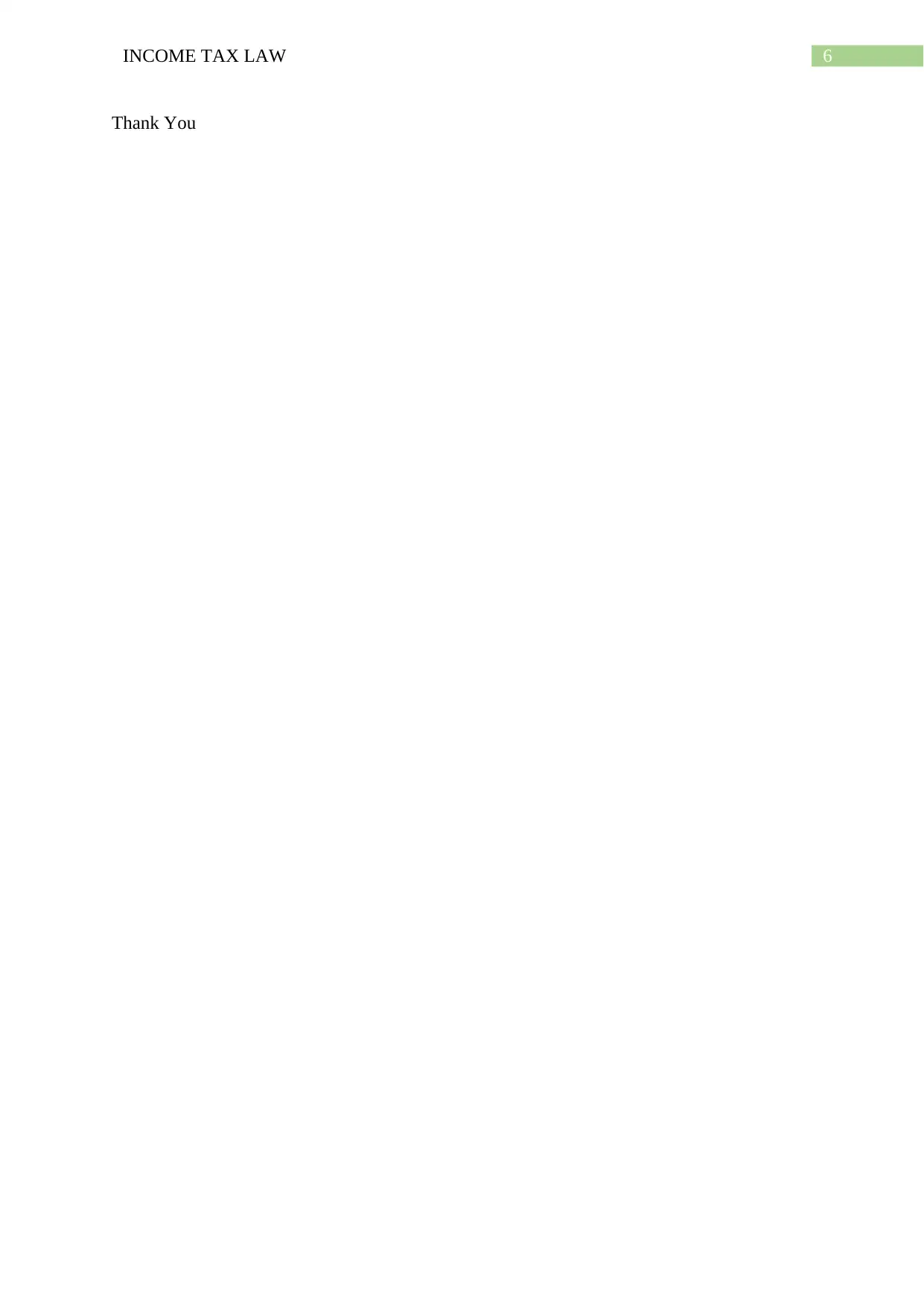
6INCOME TAX LAW
Thank You
Thank You
Paraphrase This Document
Need a fresh take? Get an instant paraphrase of this document with our AI Paraphraser
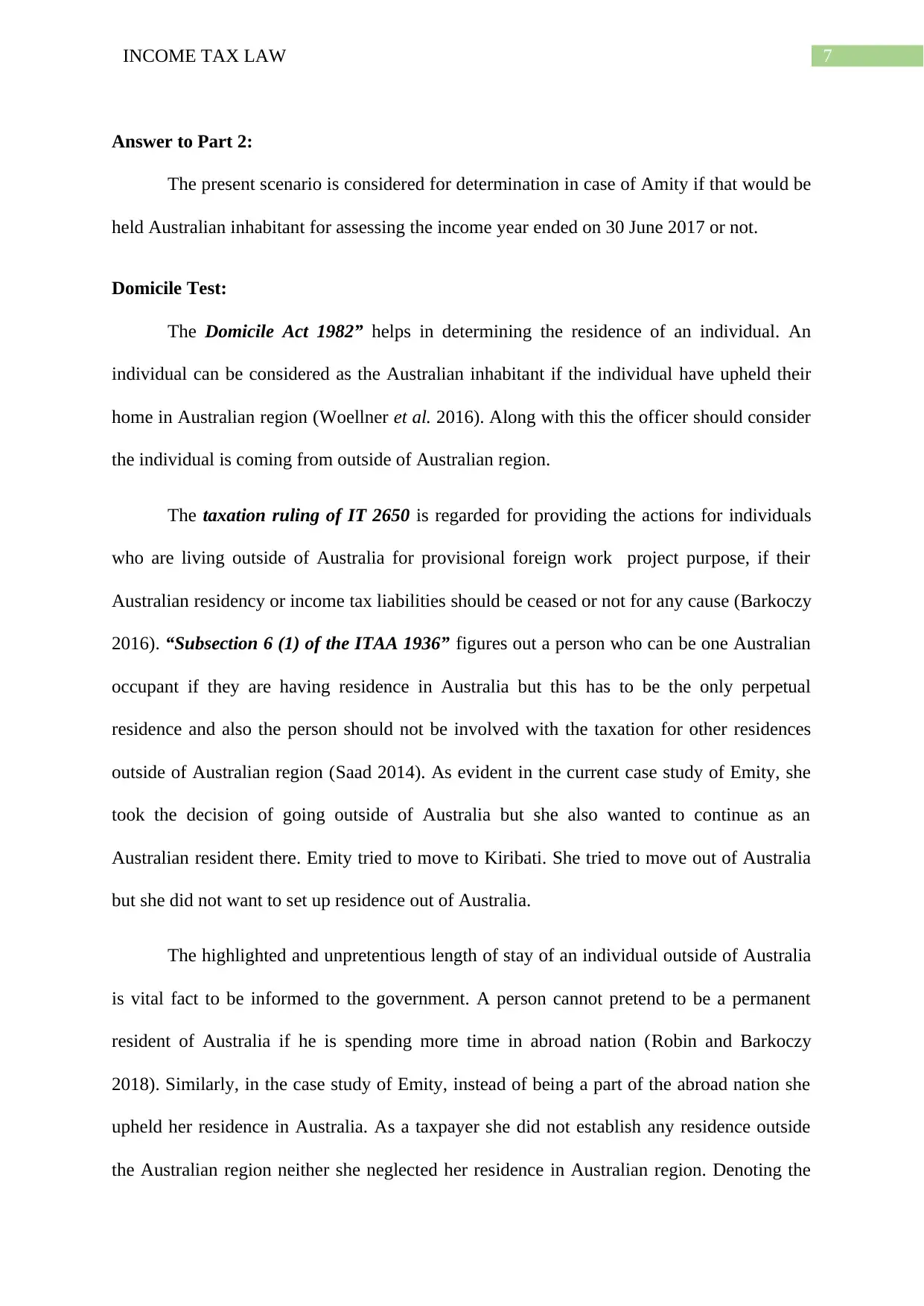
7INCOME TAX LAW
Answer to Part 2:
The present scenario is considered for determination in case of Amity if that would be
held Australian inhabitant for assessing the income year ended on 30 June 2017 or not.
Domicile Test:
The Domicile Act 1982” helps in determining the residence of an individual. An
individual can be considered as the Australian inhabitant if the individual have upheld their
home in Australian region (Woellner et al. 2016). Along with this the officer should consider
the individual is coming from outside of Australian region.
The taxation ruling of IT 2650 is regarded for providing the actions for individuals
who are living outside of Australia for provisional foreign work project purpose, if their
Australian residency or income tax liabilities should be ceased or not for any cause (Barkoczy
2016). “Subsection 6 (1) of the ITAA 1936” figures out a person who can be one Australian
occupant if they are having residence in Australia but this has to be the only perpetual
residence and also the person should not be involved with the taxation for other residences
outside of Australian region (Saad 2014). As evident in the current case study of Emity, she
took the decision of going outside of Australia but she also wanted to continue as an
Australian resident there. Emity tried to move to Kiribati. She tried to move out of Australia
but she did not want to set up residence out of Australia.
The highlighted and unpretentious length of stay of an individual outside of Australia
is vital fact to be informed to the government. A person cannot pretend to be a permanent
resident of Australia if he is spending more time in abroad nation (Robin and Barkoczy
2018). Similarly, in the case study of Emity, instead of being a part of the abroad nation she
upheld her residence in Australia. As a taxpayer she did not establish any residence outside
the Australian region neither she neglected her residence in Australian region. Denoting the
Answer to Part 2:
The present scenario is considered for determination in case of Amity if that would be
held Australian inhabitant for assessing the income year ended on 30 June 2017 or not.
Domicile Test:
The Domicile Act 1982” helps in determining the residence of an individual. An
individual can be considered as the Australian inhabitant if the individual have upheld their
home in Australian region (Woellner et al. 2016). Along with this the officer should consider
the individual is coming from outside of Australian region.
The taxation ruling of IT 2650 is regarded for providing the actions for individuals
who are living outside of Australia for provisional foreign work project purpose, if their
Australian residency or income tax liabilities should be ceased or not for any cause (Barkoczy
2016). “Subsection 6 (1) of the ITAA 1936” figures out a person who can be one Australian
occupant if they are having residence in Australia but this has to be the only perpetual
residence and also the person should not be involved with the taxation for other residences
outside of Australian region (Saad 2014). As evident in the current case study of Emity, she
took the decision of going outside of Australia but she also wanted to continue as an
Australian resident there. Emity tried to move to Kiribati. She tried to move out of Australia
but she did not want to set up residence out of Australia.
The highlighted and unpretentious length of stay of an individual outside of Australia
is vital fact to be informed to the government. A person cannot pretend to be a permanent
resident of Australia if he is spending more time in abroad nation (Robin and Barkoczy
2018). Similarly, in the case study of Emity, instead of being a part of the abroad nation she
upheld her residence in Australia. As a taxpayer she did not establish any residence outside
the Australian region neither she neglected her residence in Australian region. Denoting the
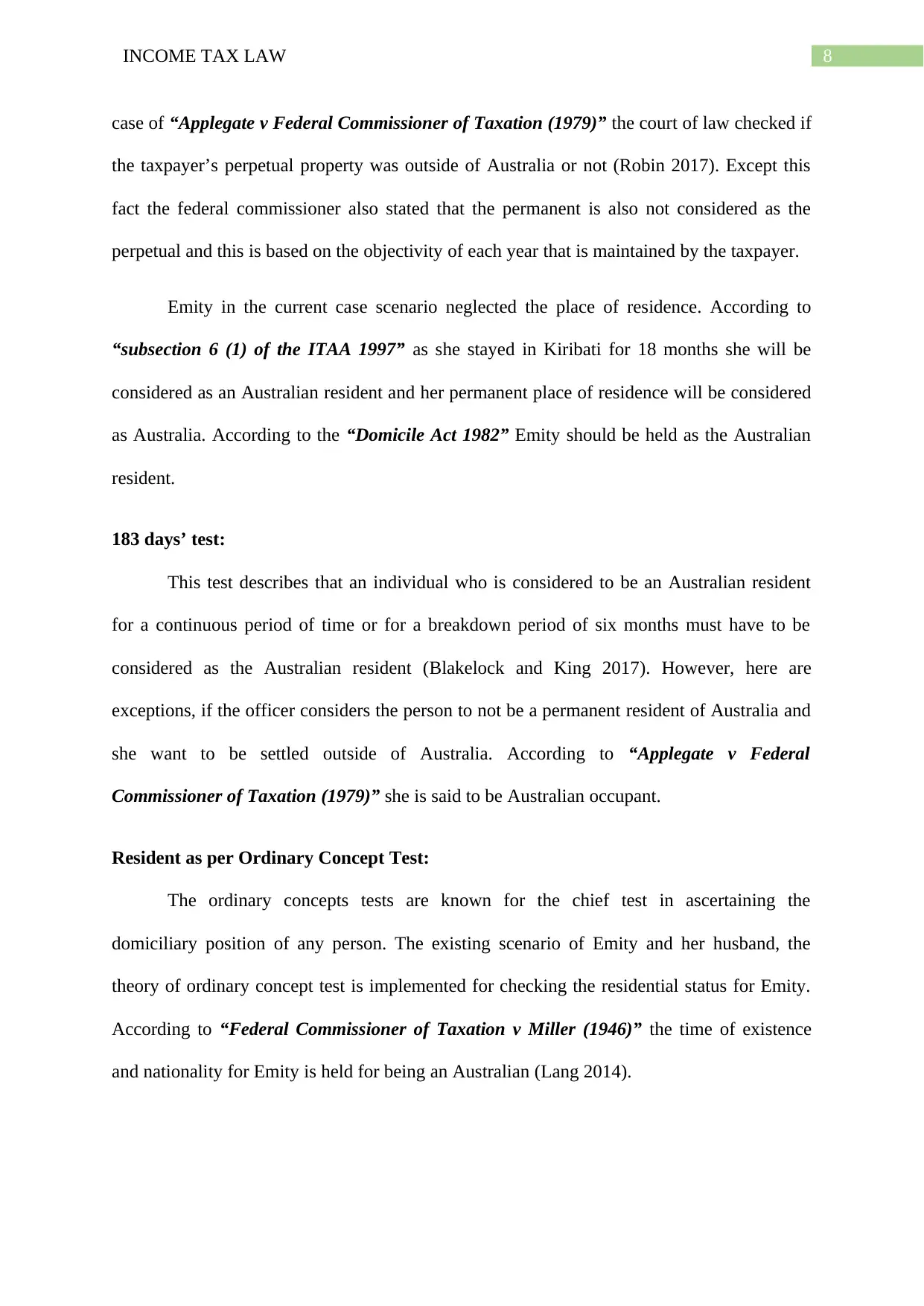
8INCOME TAX LAW
case of “Applegate v Federal Commissioner of Taxation (1979)” the court of law checked if
the taxpayer’s perpetual property was outside of Australia or not (Robin 2017). Except this
fact the federal commissioner also stated that the permanent is also not considered as the
perpetual and this is based on the objectivity of each year that is maintained by the taxpayer.
Emity in the current case scenario neglected the place of residence. According to
“subsection 6 (1) of the ITAA 1997” as she stayed in Kiribati for 18 months she will be
considered as an Australian resident and her permanent place of residence will be considered
as Australia. According to the “Domicile Act 1982” Emity should be held as the Australian
resident.
183 days’ test:
This test describes that an individual who is considered to be an Australian resident
for a continuous period of time or for a breakdown period of six months must have to be
considered as the Australian resident (Blakelock and King 2017). However, here are
exceptions, if the officer considers the person to not be a permanent resident of Australia and
she want to be settled outside of Australia. According to “Applegate v Federal
Commissioner of Taxation (1979)” she is said to be Australian occupant.
Resident as per Ordinary Concept Test:
The ordinary concepts tests are known for the chief test in ascertaining the
domiciliary position of any person. The existing scenario of Emity and her husband, the
theory of ordinary concept test is implemented for checking the residential status for Emity.
According to “Federal Commissioner of Taxation v Miller (1946)” the time of existence
and nationality for Emity is held for being an Australian (Lang 2014).
case of “Applegate v Federal Commissioner of Taxation (1979)” the court of law checked if
the taxpayer’s perpetual property was outside of Australia or not (Robin 2017). Except this
fact the federal commissioner also stated that the permanent is also not considered as the
perpetual and this is based on the objectivity of each year that is maintained by the taxpayer.
Emity in the current case scenario neglected the place of residence. According to
“subsection 6 (1) of the ITAA 1997” as she stayed in Kiribati for 18 months she will be
considered as an Australian resident and her permanent place of residence will be considered
as Australia. According to the “Domicile Act 1982” Emity should be held as the Australian
resident.
183 days’ test:
This test describes that an individual who is considered to be an Australian resident
for a continuous period of time or for a breakdown period of six months must have to be
considered as the Australian resident (Blakelock and King 2017). However, here are
exceptions, if the officer considers the person to not be a permanent resident of Australia and
she want to be settled outside of Australia. According to “Applegate v Federal
Commissioner of Taxation (1979)” she is said to be Australian occupant.
Resident as per Ordinary Concept Test:
The ordinary concepts tests are known for the chief test in ascertaining the
domiciliary position of any person. The existing scenario of Emity and her husband, the
theory of ordinary concept test is implemented for checking the residential status for Emity.
According to “Federal Commissioner of Taxation v Miller (1946)” the time of existence
and nationality for Emity is held for being an Australian (Lang 2014).
⊘ This is a preview!⊘
Do you want full access?
Subscribe today to unlock all pages.

Trusted by 1+ million students worldwide
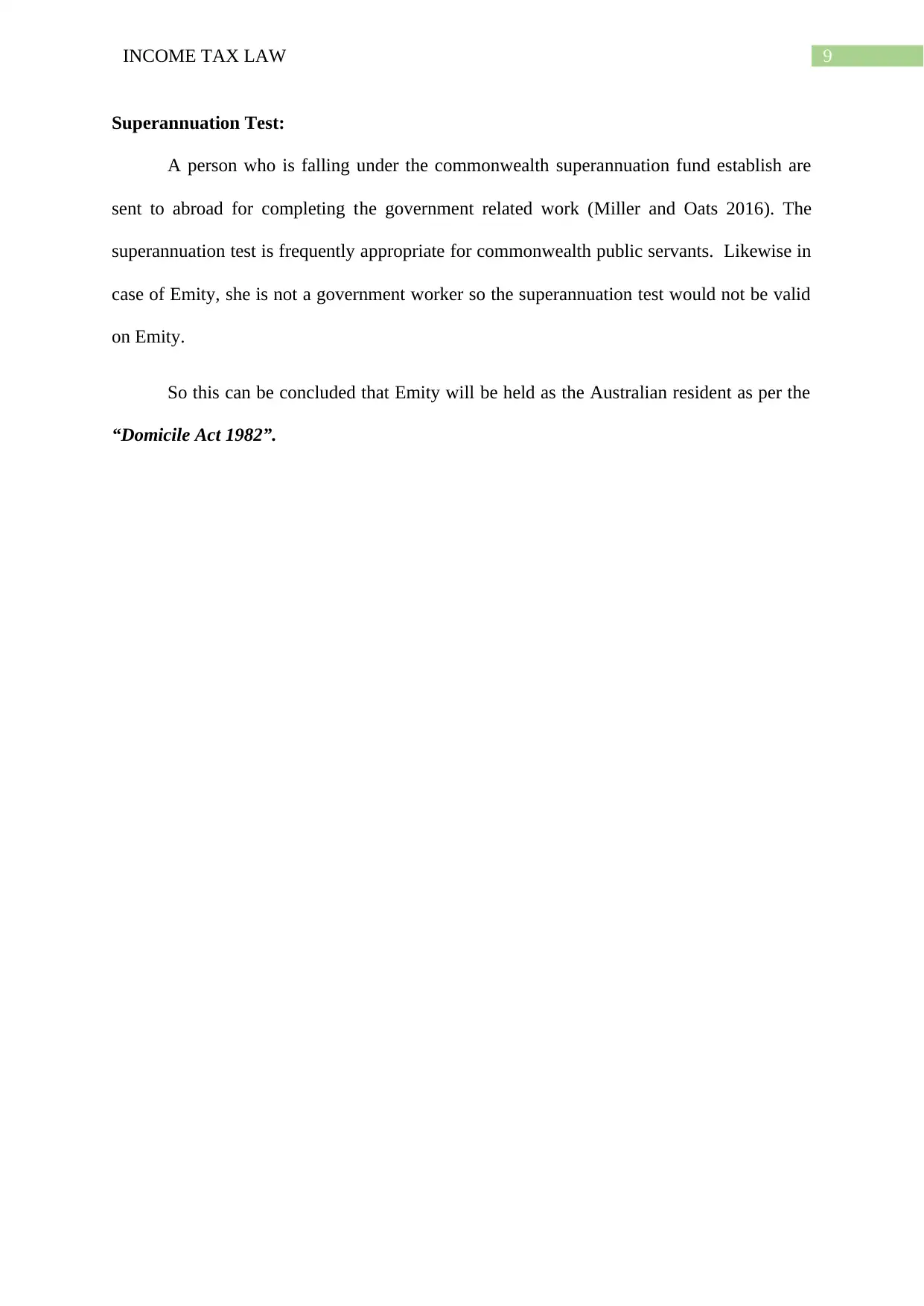
9INCOME TAX LAW
Superannuation Test:
A person who is falling under the commonwealth superannuation fund establish are
sent to abroad for completing the government related work (Miller and Oats 2016). The
superannuation test is frequently appropriate for commonwealth public servants. Likewise in
case of Emity, she is not a government worker so the superannuation test would not be valid
on Emity.
So this can be concluded that Emity will be held as the Australian resident as per the
“Domicile Act 1982”.
Superannuation Test:
A person who is falling under the commonwealth superannuation fund establish are
sent to abroad for completing the government related work (Miller and Oats 2016). The
superannuation test is frequently appropriate for commonwealth public servants. Likewise in
case of Emity, she is not a government worker so the superannuation test would not be valid
on Emity.
So this can be concluded that Emity will be held as the Australian resident as per the
“Domicile Act 1982”.
Paraphrase This Document
Need a fresh take? Get an instant paraphrase of this document with our AI Paraphraser
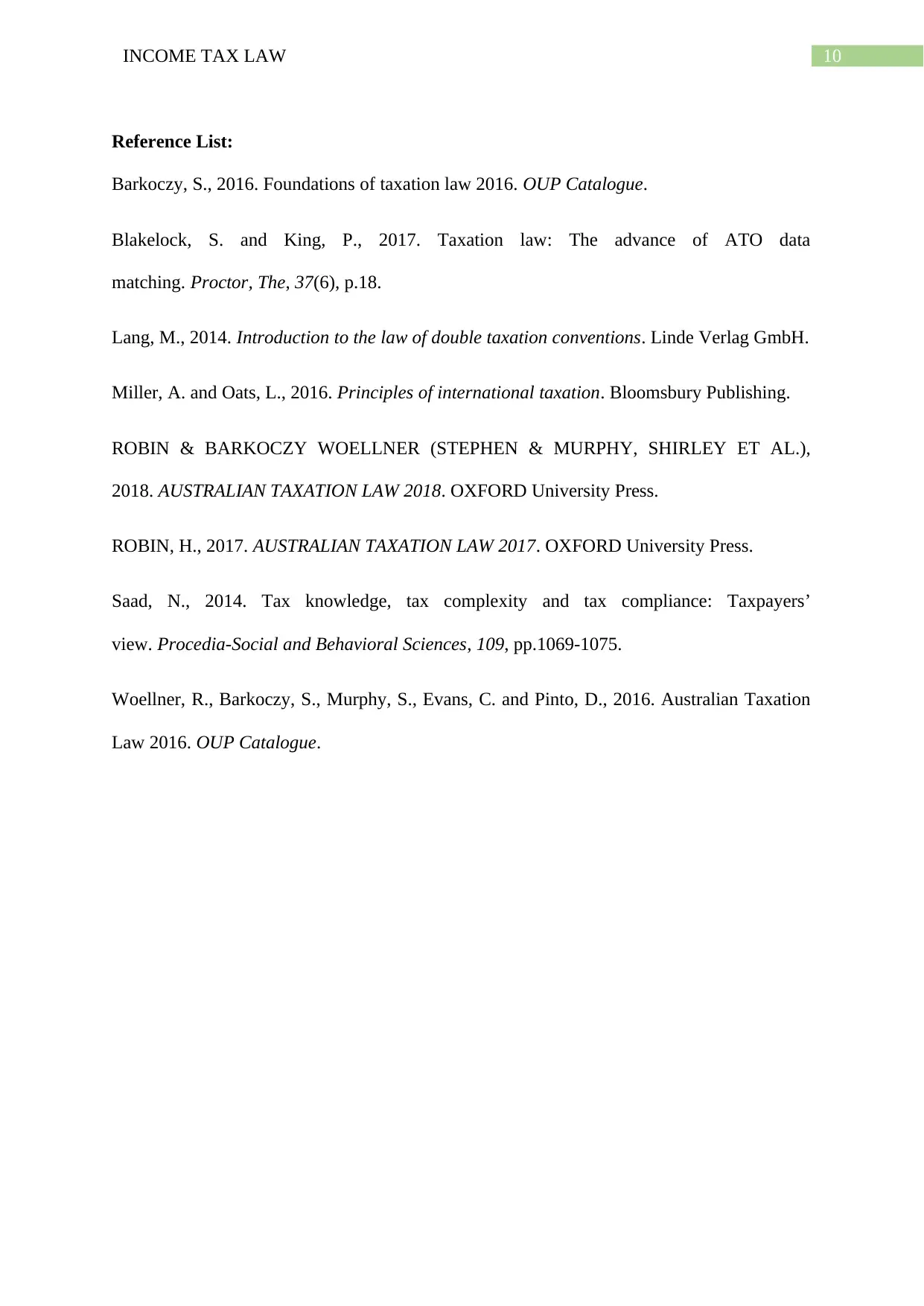
10INCOME TAX LAW
Reference List:
Barkoczy, S., 2016. Foundations of taxation law 2016. OUP Catalogue.
Blakelock, S. and King, P., 2017. Taxation law: The advance of ATO data
matching. Proctor, The, 37(6), p.18.
Lang, M., 2014. Introduction to the law of double taxation conventions. Linde Verlag GmbH.
Miller, A. and Oats, L., 2016. Principles of international taxation. Bloomsbury Publishing.
ROBIN & BARKOCZY WOELLNER (STEPHEN & MURPHY, SHIRLEY ET AL.),
2018. AUSTRALIAN TAXATION LAW 2018. OXFORD University Press.
ROBIN, H., 2017. AUSTRALIAN TAXATION LAW 2017. OXFORD University Press.
Saad, N., 2014. Tax knowledge, tax complexity and tax compliance: Taxpayers’
view. Procedia-Social and Behavioral Sciences, 109, pp.1069-1075.
Woellner, R., Barkoczy, S., Murphy, S., Evans, C. and Pinto, D., 2016. Australian Taxation
Law 2016. OUP Catalogue.
Reference List:
Barkoczy, S., 2016. Foundations of taxation law 2016. OUP Catalogue.
Blakelock, S. and King, P., 2017. Taxation law: The advance of ATO data
matching. Proctor, The, 37(6), p.18.
Lang, M., 2014. Introduction to the law of double taxation conventions. Linde Verlag GmbH.
Miller, A. and Oats, L., 2016. Principles of international taxation. Bloomsbury Publishing.
ROBIN & BARKOCZY WOELLNER (STEPHEN & MURPHY, SHIRLEY ET AL.),
2018. AUSTRALIAN TAXATION LAW 2018. OXFORD University Press.
ROBIN, H., 2017. AUSTRALIAN TAXATION LAW 2017. OXFORD University Press.
Saad, N., 2014. Tax knowledge, tax complexity and tax compliance: Taxpayers’
view. Procedia-Social and Behavioral Sciences, 109, pp.1069-1075.
Woellner, R., Barkoczy, S., Murphy, S., Evans, C. and Pinto, D., 2016. Australian Taxation
Law 2016. OUP Catalogue.
1 out of 11
Related Documents
Your All-in-One AI-Powered Toolkit for Academic Success.
+13062052269
info@desklib.com
Available 24*7 on WhatsApp / Email
![[object Object]](/_next/static/media/star-bottom.7253800d.svg)
Unlock your academic potential
Copyright © 2020–2025 A2Z Services. All Rights Reserved. Developed and managed by ZUCOL.





